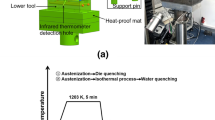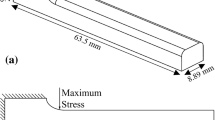Abstract
This study evaluated the cold cracking susceptibility of high-strength bainitic steels having a strength level of over 800 MPa and 1.1 GPa according to their respective chemical compositions. For evaluation of cold cracking susceptibility, a modified implant test was employed. Two different shielding gases (100% CO2 gas and 98% CO2 mixed with 2% H2 gas) were used to estimate the effect of diffusible hydrogen on the cold cracking. The diffusible hydrogen contents measuring 100% CO2 and 98% CO2+2% H2 gas were recorded as 0.58 and 9.01 ml/100 g, respectively. In the case of the lower hydrogen content, cold cracking susceptibility was very low in spite of the very high strength of the base steel regardless of chemical composition and rolling condition. However, when the mixed shielding gas was used, cold cracking susceptibility increased due to an increase in the hydrogen content. Most notably, the cold cracking resistance of steels containing higher alloy content deteriorated significantly due to the higher hardness of the coarsegrained heat-affected zone. However, the effect of the rolling condition on the cold cracking susceptibility turned out to be negligible compared to that of the chemical composition.
Similar content being viewed by others
References
N. Eliaz, A. Shachar, B. Tal, and D. Eliezer, Eng. Fail. Anal. 9, 167 (2002).
T. Michler and J. Naumann, Int. J. Hydrog. Energy 35, 821 (2010).
J. Ham, B. Kim, and S. Lee, Korean J. Met. Mater. 49, 1 (2011).
S. Kou, Welding Metallurgy 2nd ed., pp.410–417, John Wiley & Sons, Inc., New Jersey (2003).
Y. Ito and K. Bessyo, J. JWS. 37, 683 (1968).
J. S. Seo, H. J. Kim, and H. S. Ryoo, Met. Mater. Int. 14, 515 (2008).
J. H. Kim, J. S. Seo, H. J. Kim, H. S. Ryoo, K. H. Kim, and M. Y. Huh, Met. Mater. Int. 14, 239 (2008).
J. M. Sawhill, Jr., A. W. Dix, and W. F. Savage, Weld. J. 53, 554s (1974).
F. Matsuda, H. Nakagawa, T. Tsuji, and M. Tsukamoto, Trans. JWRI 7, 71 (1978).
F. Matsuda, H. Nakagawa, T. Tsuji, and M. Tsukamoto, Trans. JWRI 7, 195 (1978).
H. Yara, Y. Makishi, K. Heshiki, H. Nakagawa, and F. Matsuda, Trans. JWRI 13, 249 (1984).
E. G. Signes and P. Howe, Weld. J. 67, 163s (1988).
S. A. Gedeon and T. W. Eagar, Weld. J. 69, 213s (1990).
G. Magudeeswaran, V. Balasubramanian, and G. Madhusudhan Reddy, Int. J. Hydrog. Energy 33, 1897 (2008).
G. Magudeeswaran, V. Balasubramanian, and G. Madhusudhan Reddy, J. Mater. Sci. Technol. 25, 516 (2009).
K. Venkatesan, R. Sivasankari, V. Balusamy, A. Saxena, P. Jha, and R. Datta, Mater. Manuf. Process. 25, 175 (2010).
S. Manimozhi, S. Suresh, and V. Muthupandi, Int. J. Adv. Manuf. Technol. 51, 217 (2010).
IIW Document No. IIS/IIW-802-84 (ex Doc. IX-1240-82), International Institute of Welding (1984).
JIS Z 3118, Japanese Industrial Standard 1st, 416 (1992).
W. F. Smith, Structure and Properties of Engineering Alloys 2nd ed., pp.26–39, McGraw-Hill, Inc., New York (1993).
G. Krauss, Mater. Sci. Eng. A 273–275, 40 (1999).
K. Maweja, W. Stumpf, and N. Berg, Mater. Sci. Eng. A 519, 121 (2009).
K. W. Andrew, JISI 203, 721 (1965).
AWS D 1.1, Structural Welding Code, American Welding Society (2000).
ASME B&PV sec VIII Div. 1 Appendix R, American Society of Mechanical Engineer (1998).
BS 5153: British Standard Specification for arc Welding of Carbon and Carbon Manganese Steel, British Standard (1984).
T. Kasuya, N. Yurioka, and M. Okumura, Nippon Steel Technical Report No. 65, 7 (1995).
Author information
Authors and Affiliations
Corresponding author
Rights and permissions
About this article
Cite this article
Kim, S., Seo, J.S. & Lee, C. Cold cracking susceptibility of boron added high-strength bainitic steels. Met. Mater. Int. 18, 1029–1036 (2012). https://doi.org/10.1007/s12540-012-6015-2
Received:
Accepted:
Published:
Issue Date:
DOI: https://doi.org/10.1007/s12540-012-6015-2




